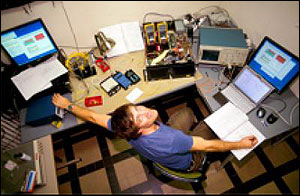
Hackers Test Quantum Cryptography Security
TRONDHEIM, Norway, Sept. 15, 2010 — A new technique that exploits imperfections in quantum cryptography systems has been developed and tested by the Norwegian University of Science and Technology (NTNU), the University of Erlangen-Nürnberg and the Max Planck Institute for the Science of Light. Countermeasures were also implemented within an ongoing collaboration with leading manufacturer ID Quantique.

A security researcher (PhD student Lars Lydersen) is testing a commercial quantum cryptography system in a laboratory, to confirm the security vulnerability. (Image: NTNU)
Quantum cryptography is a technology that allows one to distribute a cryptographic key across an optical network and to exploit the laws of quantum physics to guarantee its secrecy. It makes use of the Heisenberg uncertainty principle — observation causes perturbation – to reveal eavesdropping on an optical fiber.
The technology was invented in the mid-1980s, with first demonstration less than a decade later and the launch of commercial products during the first years of the century.
Although the security of quantum cryptography relies in principle only on the laws of quantum physics, it is also dependent on the lack of loopholes in specific implementations, just like any other security technology.
"The security of quantum cryptography relies on quantum physics but not only… It must also be properly implemented. This fact was often overlooked in the past," said Professor Gerd Leuchs of the University of Erlangen-Nürnberg and the Max Planck Institute for the Science of Light.
Recently, NTNU in collaboration with the Max Planck team has found a technique to remotely control a key component of most of today's quantum cryptography systems — the photon detector.
"Unlike previously published attempts, this attack is implementable with current off-the-shelf components," said Dr. Vadim Makarov, a researcher in the Quantum Hacking group at NTNU. "Our eavesdropping method worked both against MagiQ Technology's QPN 5505 and ID Quantique Clavis2 systems."
In the framework of a collaboration initiated with ID Quantique, the researchers shared their results with the company prior to publication. ID Quantique has then, with a help of NTNU, developed and tested a countermeasure.
Academic researchers of the two laboratories will continue testing security aspects of quantum cryptography solutions from ID Quantique.
"Testing is a necessary step to validate a new security technology and the fact that this process is applied today to quantum cryptography is a sign of maturity for this technology," said Grégoire Ribordy, CEO of ID Quantique.
For more information, visit: www.ntnu.edu
Published: September 2010